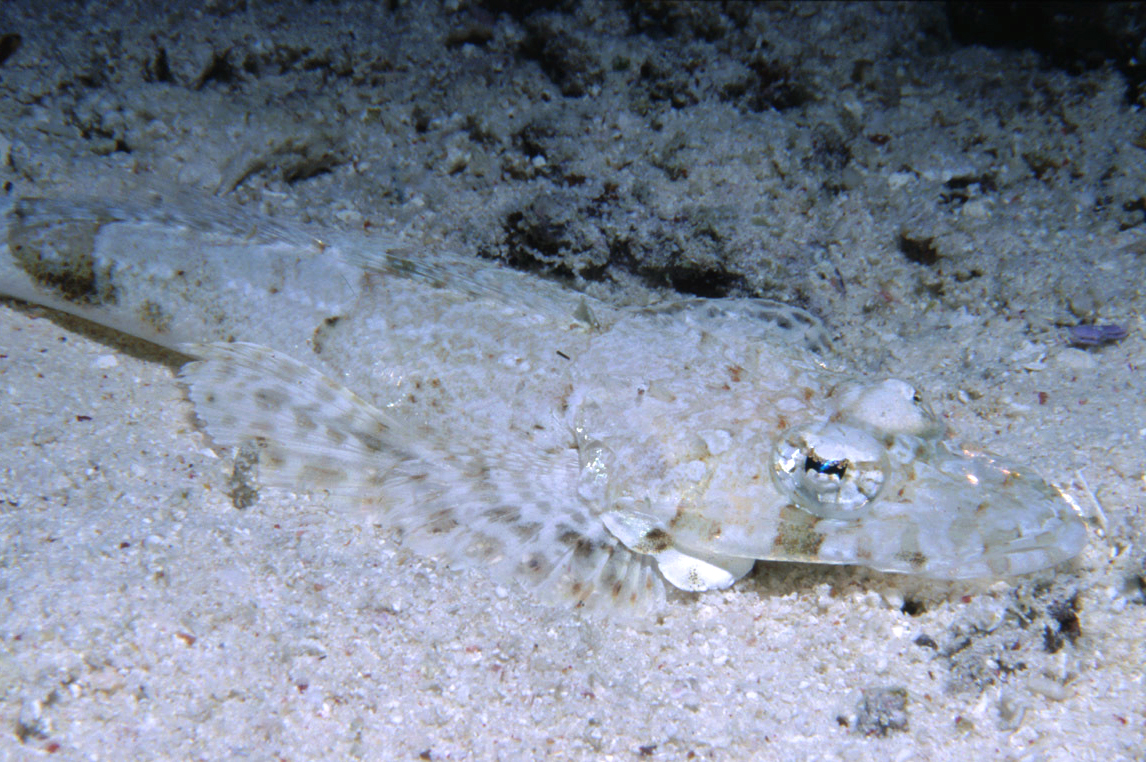Longsnout Flathead, Thysanophrys chiltonae Schultz 1966

A Longsnout Flathead, Thysanophrys chiltonae, on Mantis Reef, Great Barrier Reef, Queensland, November 2001. Source: Erik Schlogl / iNaturalist.org. License: CC by Attribution-NonCommercial
Longsnout Flathead, Thysanophrys chiltonae Schultz 1966
More Info
|
Distribution |
NE of Monte Bello Islands and offshore reefs of Western Australia, Ashmore Reef in the Timor Sea, to off North Stradbroke Island, Queensland, including reefs in the Coral Sea. Elsewhere the species occurs in the tropical Red Sea and Indo-west-central Pacific: East Africa to the Marquesas Islands, north to the Ryukyu Islands, Japan, and south to New Caledonia, Tonga, and northern Australia. Inhabits sandy areas, in lagoons, bays and coastal waters around coral reefs, at depths to about 70 m. Often lies buried or partly buried in sand. |
|
Features |
Dorsal fin IX, I,VIII, or I,VII, 11-12 (usually 11); Anal fin 12; Pectoral fin 19-22 (usually 20 or 21); Pelvic fin I, 5; Lateral line scales 50-54 (usually 52 or 53). Body elongate, slightly depressed. Head large (length ~38% SL), moderately depressed; snout elongate; preorbital spines 1-3; preocular spine 1; supraorbital ridge smooth over anterior half of eye, with serrations posteriorly; suborbital ridge with about 6 or 7 spines; eyes large (~19-24% HL), least interorbital width 3.8-7.2 times in greatest eye diameter; teeth on vomer in 2 separate patches; preopercular spines 3, upper longest, accessory spine usually absent; interopercular margin incised, forming a broad lobe; total gill rakers on first gill arch 5-7 (usually 6). Scales small, finely ctenoid dorsally, cycloid below, covering body and most of head behind eyes; lateral line scales slightly smaller than adjacent scales on side, oblique scale rows slanting downward above lateral line about equal to number of lateral-line scales; lateral-line scales 50-54 (usually 52 or 53), anterior 1-3 (usually 3) lateral-line scales bearing a small spine. First dorsal fin spinous with short base, first spine very short, detached, following spines much longer. Second dorsal fin with moderately long base, anterior rays longest, nearly as long as longest first dorsal spines. Anal fin opposite and slightly longer-based than second dorsal fin. Caudal fin truncate to slightly rounded. Pectoral fins moderately small. Pelvic fins long, extending past anal fin origin; based below centre of pectoral fins. |
|
Size |
Maximum length about 25 cm, commonly to 16 cm TL. |
|
Colour |
Well-camouflaged to match the surroundings. Body light tan, mottled with numerous white spots dorsally, whitish below, 5-7 brown bands across back; lips with alternating white and brown bands; a broad brown suborbital bar present. Caudal fin with weak brown bars; pectoral fin with numerous dark spots forming weak bars; pelvic fin with 3-5 brown bars. |
|
Fisheries |
May be taken in trawls or on hook and line. |
|
Etymology |
Thysanophrys is from the Greek thysanos, meaning “tassell”, and ophrys, meaning “eye brow” in reference to the papilla on the upper part of the eye. |
|
Species Citation |
Thysanophrys chiltonae Schultz, In Schultz et al., 1966, Bull. U. S. Natl. Mus. 202(3): 57, figs. 146-147. Type locality: Coral head near north end of Lagoon at Rongelap Island, Rongelap Atoll, Marshall Islands, western Pacific, depth 18 feet. |
|
Author |
Australian National Fish Collection, CSIRO & Bray, D.J. 2020 |
|
Resources |
Longsnout Flathead, Thysanophrys chiltonae Schultz 1966
References
Allen, G.R. & Erdmann, M.V. 2012. Reef fishes of the East Indies. Perth : Tropical Reef Research 3 vols, 1260 pp.
Allen, G.R. & Russell, B.C. 1986. Part VII Fishes. pp. 79-103 in Berry, P.F. (ed.) Faunal Surveys of the Rowley Shoals, Scott Reef and Seringapatam Reef, northwestern Australia. Records of the Western Australian Museum, Supplement 25: 1-106
Imamura, H. 1996. Phylogeny of the family Platycephalidae and related taxa (Pisces: Scorpaeniformes). Species Diversity 1(2): 123-233.
Imamura, H., Ida, H. & Moyer, J.T. 1995. Redescription of a flathead, Thysanophrys otaitensis (Scorpaeniformes: Platycephalidae). Japanese Journal of Ichthyology 42(3/4): 277-283.
Imamura, H. & Knapp, L.W. 1999. Thysanophrys papillaris, a new species of flathead from the Andaman Sea and northern Australia (Scorpaeniformes: Platycephalidae). Ichthyological Research 46(2): 179-183
Knapp, L.W. 1999. Family Platycepalidae. pp. 2385-2421 in Carpenter, K.E. & Niem, T.H. (eds). The Living Marine Resources of the Western Central Pacific. FAO Species Identification Guide for Fisheries Purposes. Rome : FAO Vol. 4 pp. 2069-2790.
Knapp, L.W. 2013. Descriptions of four new species of Thysanophrys (Scorpaeniformes: Platycephalidae) from the Western Indian Ocean. Zootaxa 3608(2): 127-136 https://doi.org/10.11646/zootaxa.3608.2.3
Kuiter, R.H. & Tonozuka, T. 2001. Pictorial guide to Indonesian reef fishes. Part 1. Eels- Snappers, Muraenidae - Lutjanidae. Seafood, Australia : Zoonetics, 302 pp.
Larson, H.K., Williams, R.S. & Hammer, M.P. 2013. An annotated checklist of the fishes of the Northern Territory, Australia. Zootaxa 3696(1): 1-293
Motomura, H. & Matsuura, K. 2016. Thysanophrys chiltonae. The IUCN Red List of Threatened Species 2016: e.T69800704A69800897. http://dx.doi.org/10.2305/IUCN.UK.2016-3.RLTS.T69800704A69800897.en. Downloaded on 16 November 2018.
Randall, J.E. 2005. Reef and shore fishes of the South Pacific. New Caledonia to Tahiti and the Pitcairn Islands. University of Hawaii Press, Honolulu, Hawaii.
Randall, J.E., G.R. Allen & R.C. Steene. 1990 Fishes of the Great Barrier Reef and Coral Sea. University of Hawaii Press, Honolulu, Hawaii. 506 pp.
Randall, J.E., Allen, G.R. & Steene, R. 1997. Fishes of the Great Barrier Reef and Coral Sea. Bathurst : Crawford House Press 557 pp. figs.
Russell, B.C. 1983. Annotated checklist of the coral reef fishes in the Capricorn-Bunker group, Great Barrier Reef, Australia. Great Barrier Reef Marine Park Authority. Special Publication Series 1: 1-184 figs 1-2
Russell, B.C., Larson, H.K., Hutchins, J.B. & Allen, G.R. 2005. Reef fishes of the Sahul Shelf. The Beagle, Records of the Museums and Art Galleries of the Northern Territory Supplement 1 2005: 83-105
Schultz, L.P. 1966. Family Platycephalidae: flatheads. pp. 45-62, figs 144-148, pl. 130 in Schultz, L.P., Woods, L.P. & Lachner, E.A. (eds). Fishes of the Marshall and Marianas Islands. Vol. 3. Families Kraemeriidae through Antennariidae. Bulletin of the United States National Museum 202(3): 1-176, figs 133-156, pls 124-148 https://www.biodiversitylibrary.org/page/7886373#page/5/mode/1up












